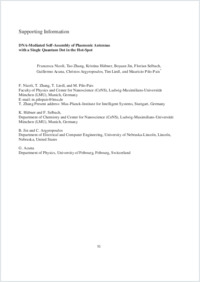DNA‐mediated self‐assembly of plasmonic antennas with a single quantum dot in the hot spot
- Nicoli, Francesca Faculty of Physics and Center for Nanoscience (CeNS), Ludwig-Maximilians-Universität München (LMU), Munich, Germany
- Zhang, Tao Faculty of Physics and Center for Nanoscience (CeNS), Ludwig-Maximilians-Universität München (LMU), Munich, Germany
- Hübner, Kristina Department of Chemistry and Center for Nanoscience (CeNS), Ludwig-Maximilians-Universität München, Germany
- Jin, Boyuan Department of Electrical and Computer Engineering, University of Nebraska-Lincoln, Lincoln, Nebraska, United States
- Selbach, Florian Department of Chemistry and Center for Nanoscience (CeNS), Ludwig-Maximilians-Universität München, Germany
- Acuna, Guillermo P. Department of Physics, University of Fribourg, Switzerland
- Argyropoulos, Christos Department of Electrical and Computer Engineering, University of Nebraska-Lincoln, Lincoln, Nebraska, United States
- Liedl, Tim Faculty of Physics and Center for Nanoscience (CeNS), Ludwig-Maximilians-Universität München (LMU), Munich, Germany
- Pilo-Pais, Mauricio Faculty of Physics and Center for Nanoscience (CeNS), Ludwig-Maximilians-Universität München (LMU), Munich, Germany
-
2019
Published in:
- Small. - 2019, vol. 15, no. 26, p. 1804418
English
DNA self‐assembly is a powerful tool to arrange optically active components with high accuracy in a large parallel manner. A facile approach to assemble plasmonic antennas consisting of two metallic nanoparticles (40 nm) with a single colloidal quantum dot positioned at the hot spot is presented here. The design approach is based on DNA complementarity, stoichiometry, and steric hindrance principles. Since no intermediate molecules other than short DNA strands are required, the structures possess a very small gap (≈ 5 nm) which is desired to achieve high Purcell factors and plasmonic enhancement. As a proof‐of‐concept, the fluorescence emission from antennas assembled with both conventional and ultrasmooth spherical gold particles is measured. An increase in fluorescence is obtained, up to ≈30‐fold, compared to quantum dots without antenna.
- Faculty
- Faculté des sciences et de médecine
- Department
- Département de Physique
- Language
-
- English
- Classification
- Physics
- License
- License undefined
- Identifiers
-
- RERO DOC 326999
- DOI 10.1002/smll.201804418
- Persistent URL
- https://folia.unifr.ch/unifr/documents/308013
Other files
Statistics
Document views: 63
File downloads:
- acu_dms.pdf: 208
- acu_dms_sm.pdf: 127

